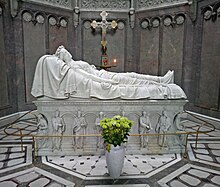Elisabeth Mikhailovna Romanova

Elisabeth Michailowna of Russia ( Russian Елизавета Михайловна Романова ; * July 14th / May 26th, 1826 greg. In Moscow ; † January 28, 1845 in Wiesbaden ) was a Russian Grand Duchess and Duchess of Nassau .
origin
She was born in the Moscow Kremlin as the daughter of Grand Duke Michael Pavlovich of Russia (1798–1849) and Grand Duchess Elena Pawlowna , nee Princess Charlotte of Württemberg . About her father, Elisabeth was the granddaughter of Tsar Paul and niece of Tsars Alexander I and Nicholas I. Elisabeth was named after her aunt, Tsarina Elizabeth Alexejewna and a close friend of her mother's.
Life
She grew up in Saint Petersburg and was known for her beauty. In 1843, Duke Adolf von Nassau , who later became the Grand Duke of Luxembourg, visited Russia and met Elisabeth for the first time. Adolf's stepmother was Princess Pauline von Württemberg , Elisabeth's maternal aunt. Adolf and Elisabeth fell in love and were married on January 31, 1844 in St. Petersburg. Elisabeth was 17 years old, Adolf was already 26. After the marriage, the couple stayed in Russia for a short time and then moved to their residence in Biebrich am Rhein near Wiesbaden. Elisabeth, now Duchess of Nassau , was very popular with the people and the couple lived very happily together.
death
In January 1845, however, Elisabeth died giving birth to a daughter who also did not survive the birth. The deeply grieving Duke ordered the establishment of a Russian Orthodox Church in Wiesbaden, the Russian Orthodox Church of Saint Elizabeth , which was to receive the bones of his beloved wife. The Orthodox Duchess was only allowed to be buried in a place consecrated according to the Orthodox rite, for which the Russian legation chapel on Rheinstrasse was unsuitable. The hill location of the church on the Neroberg was personally chosen by Adolf, so that he always had the church in view from his residence. The high dowry of the Duchess, a gift from the Tsar for his niece, was used to build the church at the pious wish of Duke Adolf and at the will of the Tsar. For this purpose, Duke Adolf had previously sent his court architect Philipp Hoffmann to Russia, to Elisabeth's homeland, so that he could study the local church architecture.
Web links
- Biography, PDF document
- IS Semyonov: Christian Dynasties in Europe (Христианские династии Европы), Olma Media Group, 2002, page 425 (Russian)
- Nassau, Elisabeth Duchess of. Hessian biography. (As of January 21, 2020). In: Landesgeschichtliches Informationssystem Hessen (LAGIS).
| personal data | |
|---|---|
| SURNAME | Romanowa, Elisabeth Mikhailovna |
| ALTERNATIVE NAMES | Elisabeth Mikhailovna of Russia; Романова, Елизавета Михайловна (Russian) |
| BRIEF DESCRIPTION | Russian Grand Duchess and Duchess of Nassau |
| DATE OF BIRTH | May 26, 1826 |
| PLACE OF BIRTH | Moscow |
| DATE OF DEATH | January 28, 1845 |
| Place of death | Wiesbaden |
